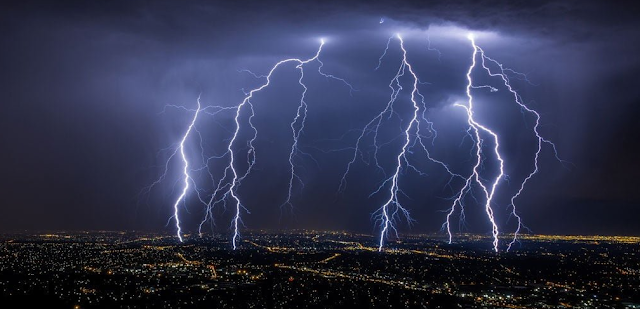Thunder and lightning are two of nature's most awe-inspiring and powerful phenomena. While they are often experienced together, they are distinct events that are caused by different processes within the atmosphere. This article will explore the causes of thunder, why it occurs during and after rain, and the mechanisms behind lightning. We will also clarify the connection between thunderstorms and rainfall and debunk common myths surrounding these events.
What is Thunder and Lightning?
To understand thunder, it is crucial first to know about
lightning. Lightning is an electrical discharge that occurs between
electrically charged regions within clouds or between a cloud and the ground.
This discharge generates a huge release of energy, which rapidly heats the
surrounding air to temperatures hotter than the surface of the sun—around
30,000 Kelvin (53,540°F). The rapid expansion of this superheated air creates a
shockwave, which we perceive as thunder.
Thunder itself is the sound produced by this
shockwave. Since sound travels slower than light, we often see the flash of
lightning before we hear the rumble of thunder. The time delay between seeing
lightning and hearing thunder can give us a rough idea of how far away the
lightning strike occurred, as light travels much faster than sound.
Causes of Thunder and Lightning
Thunder and lightning are most commonly associated with
thunderstorms, which occur when warm, moist air rises rapidly in the atmosphere
and cools, forming large cumulonimbus clouds. These towering clouds contain
strong updrafts that carry water droplets and ice particles into the upper
atmosphere. As these particles collide, they exchange electric charges. The top
of the cloud typically becomes positively charged, while the bottom becomes
negatively charged, creating a large electrical potential difference.
When the charge difference becomes large enough, it can
overcome the insulating properties of the air, causing a discharge of
electricity: lightning. This discharge travels from the cloud to the ground, or
from one cloud to another, in a series of rapid steps, releasing energy as it
goes.
Thunder During Rain
Thunder is commonly heard during or just after rainstorms
because thunderstorms and rain are linked by the same atmospheric processes. As
rain falls, it often originates from the same cloud that produced the
lightning. The intense updrafts within the storm cloud, which are responsible
for forming lightning, also produce the conditions that lead to the formation
of raindrops.
When lightning occurs, it can heat the surrounding air to
extremely high temperatures. This rapid heating causes the air to expand
quickly, creating a shockwave. The sound from this shockwave is what we hear as
thunder. This is why thunderstorms often bring both rain and thunder in close
succession: the lightning discharge that creates thunder also contributes to
the conditions for rainfall.
Why Do We Hear Thunder After the Rain?
Thunder can be heard after the rain in some cases, depending
on the nature of the storm and the location of the lightning strike. Although
thunderstorms typically produce thunder at the same time as lightning, there
are a few reasons why thunder might be heard after rain has stopped:
- Distance
from the Lightning Strike: If the lightning strike occurs far away
from the observer, the light from the lightning travels much faster than
the sound of thunder. Therefore, even though the rain has stopped, the
sound of thunder may reach you later.
- Storm's
Position: In some storms, the lightning may have originated at a
higher altitude or within a region of the storm that is still producing
electrical discharges after the rain has ceased. The time it takes for the
thunder to reach the observer will depend on how far the storm system has
moved.
- Dissipation
of the Storm: Thunderstorms do not immediately dissipate after rain.
In fact, lightning can continue for a short time as the storm system
weakens or moves away. The thunder may lag behind because sound travels
more slowly than light, meaning the observer may hear it after the rain
stops.
The Connection Between Rain, Thunder, and Lightning
Thunderstorms, which produce both lightning and thunder, are
typically associated with rain, but not all rainstorms are thunderstorms.
Thunderstorms require specific conditions—namely, instability in the
atmosphere, moisture, and a triggering mechanism (like a cold front or a warm
air mass)—to produce lightning.
While thunder and lightning are most often observed in heavy
rainstorms, there are situations where lightning may occur without significant
rain. This is known as "dry lightning," which can be a dangerous
phenomenon in arid regions, as it can ignite wildfires without the accompanying
rain that would normally help to suppress them.
Lightning After the Rain
In some cases, lightning may still occur after the rain has
stopped. This is typically seen when a storm is in its dissipating phase. As
the storm weakens, the cloud’s electrical charge might not be fully
neutralized, leading to residual lightning strikes even though the rainfall has
ended. These “straggling” strikes can be a reminder of the storm’s lingering
power.
Conclusion
Thunder and lightning are fascinating natural phenomena that
occur due to the interaction of electrical charges within storm clouds. Thunder
is caused by the rapid expansion of air heated by lightning, and its sound
often follows the lightning strike by several seconds or more. The relationship
between rain and thunderstorms is direct—rain is produced by the same
conditions that lead to lightning and thunder, although thunder can be heard
after the rain in certain circumstances, depending on distance and storm
dynamics.
By understanding these processes, we gain a greater
appreciation for the powerful forces at work in the atmosphere. While thunder
and lightning are an integral part of storms, their effects—both awe-inspiring
and sometimes dangerous—remind us of the dynamic and ever-changing nature of
our planet’s weather systems.
Sources:
- National
Weather Service (NWS). "Thunderstorms." https://www.weather.gov/
- American
Meteorological Society. "Glossary of Meteorology." 3rd Edition.
- NOAA
National Severe Storms Laboratory. "What is Lightning?"
https://www.nssl.noaa.gov/
- Encyclopedia
Britannica. "Thunder and Lightning." https://www.britannica.com/




